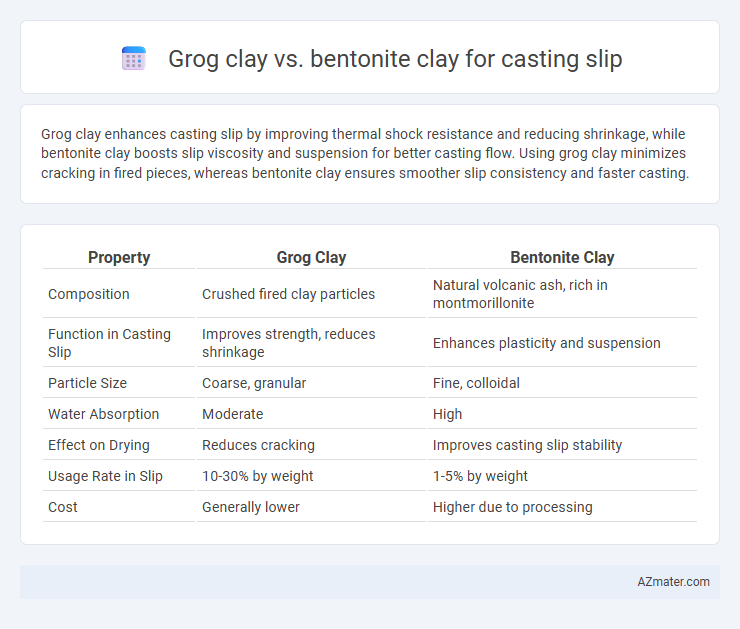Grog clay enhances casting slip by improving thermal shock resistance and reducing shrinkage, while bentonite clay boosts slip viscosity and suspension for better casting flow. Using grog clay minimizes cracking in fired pieces, whereas bentonite clay ensures smoother slip consistency and faster casting.
Table of Comparison
| Property | Grog Clay | Bentonite Clay |
|---|---|---|
| Composition | Crushed fired clay particles | Natural volcanic ash, rich in montmorillonite |
| Function in Casting Slip | Improves strength, reduces shrinkage | Enhances plasticity and suspension |
| Particle Size | Coarse, granular | Fine, colloidal |
| Water Absorption | Moderate | High |
| Effect on Drying | Reduces cracking | Improves casting slip stability |
| Usage Rate in Slip | 10-30% by weight | 1-5% by weight |
| Cost | Generally lower | Higher due to processing |
Introduction to Casting Slips
Casting slips require precise control of viscosity and particle suspension to ensure smooth mold filling and detailed surface finish. Grog clay, known for its granular, refractory particles, enhances structural integrity and reduces shrinkage during casting but may increase slurry coarseness. Bentonite clay, rich in montmorillonite minerals, acts as a powerful rheology modifier, improving slip plasticity and suspension stability, resulting in finer, more consistent casting surfaces.
What is Grog Clay?
Grog clay consists of pre-fired clay particles that are ground into granules added to casting slips to improve drying and firing performance by reducing shrinkage and warping. Compared to bentonite clay, which is a fine, highly plastic clay used to increase suspension and plasticity, grog clay enhances the structural integrity and porosity of the cast piece. This makes grog clay particularly effective in preventing cracks and deformation during the drying and firing stages of ceramic production.
What is Bentonite Clay?
Bentonite clay is a highly absorbent, fine-grained clay composed primarily of montmorillonite, prized in ceramic casting slip for its exceptional plasticity and ability to suspend fine particles evenly. Unlike grog clay, which consists of pre-fired, crushed clay particles added to reduce shrinkage and improve thermal shock resistance, bentonite enhances slip fluidity and adhesion due to its swelling properties in water. This makes bentonite clay an essential additive in casting slips, optimizing mold filling and surface finish quality.
Key Differences Between Grog and Bentonite Clay
Grog clay contains pre-fired clay particles that provide added strength, reduce shrinkage, and improve drying time in casting slips, whereas bentonite clay is a natural absorbent that enhances plasticity and suspension properties. Grog enhances structural integrity and prevents warping in ceramic pieces, while bentonite primarily improves slip consistency and fluidity for smoother casting. The choice between grog and bentonite depends on the desired texture, strength, and workability in the final ceramic product.
Physical Properties Comparison
Grog clay features coarse, fired particles that reduce shrinkage and enhance thermal shock resistance, making it ideal for casting slip requiring durability and dimensional stability. Bentonite clay contains fine, swelling particles with high plasticity and excellent water retention, improving slip fluidity and suspension but increasing drying shrinkage risk. Grog's particle size and inert nature provide superior strength in fired casts, while Bentonite's colloidal properties optimize cast surface smoothness and workability.
Impact on Casting Slip Quality
Grog clay enhances casting slip quality by improving porosity and reducing shrinkage, which minimizes cracking during drying and firing. Bentonite clay increases the slip's plasticity and suspension stability, promoting better particle dispersion and casting consistency. Combining grog and bentonite optimizes slip viscosity and strength, leading to superior mold release and surface finish in ceramic casting.
Workability and Handling
Grog clay enhances casting slip workability by improving plasticity and reducing shrinkage, facilitating smoother handling during molding. Bentonite clay increases slip viscosity and suspension stability, allowing longer open times but can lead to thicker mixtures that may require more water adjustment. Choosing between grog and bentonite clay depends on the desired balance of fluidity and slip stability for optimal casting performance.
Application Suitability: Grog vs Bentonite
Grog clay improves casting slip by enhancing shrinkage control and structural integrity, making it ideal for thicker, heavy-duty ceramic pieces and reducing cracking during drying and firing. Bentonite clay increases plasticity and suspension properties in slip, facilitating a smooth pour suitable for detailed, thin-walled castings but can lead to excessive shrinkage if overused. Selecting grog or bentonite depends on the specific casting requirements: grog for durability and dimensional stability, bentonite for fluidity and fine surface detail.
Pros and Cons of Each Clay Type
Grog clay enhances casting slip by improving thermal shock resistance and reducing shrinkage, making it ideal for larger ceramics but can increase the slip's roughness and decrease smoothness. Bentonite clay provides excellent plasticity and suspension in casting slips, ensuring uniform casting and fine surface texture; however, it can increase drying shrinkage and lead to cracking if not balanced properly. Choosing between grog and bentonite clay depends on the desired balance between strength, texture, and drying properties in the final ceramic piece.
Choosing the Right Clay for Your Casting Slip
Choosing the right clay for your casting slip significantly impacts the texture, shrinkage, and strength of the finished piece. Grog clay, enriched with pre-fired grog particles, enhances durability and reduces warping during drying and firing, making it ideal for heavier or larger casts. Bentonite clay, known for its excellent plasticity and binding properties, improves slip adhesion and fluidity but can increase drying shrinkage, suitable for finer, more detailed molds where smooth surfaces are essential.

Infographic: Grog clay vs Bentonite clay for Casting slip
 azmater.com
azmater.com